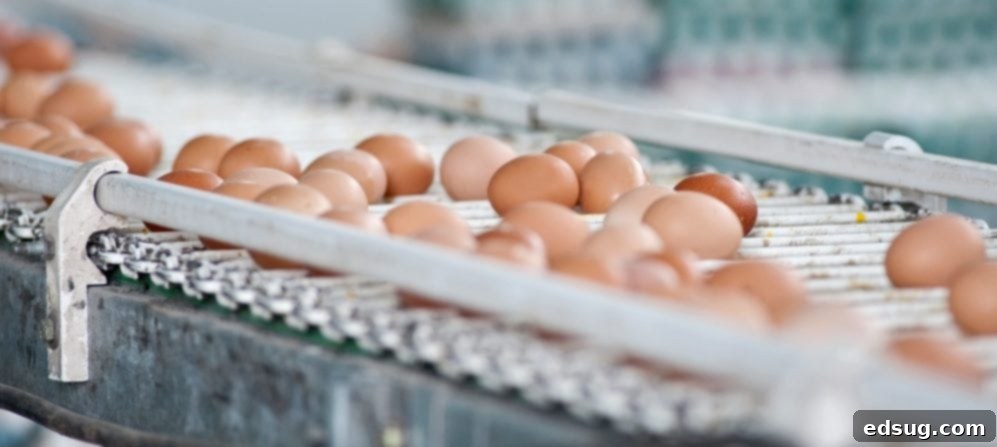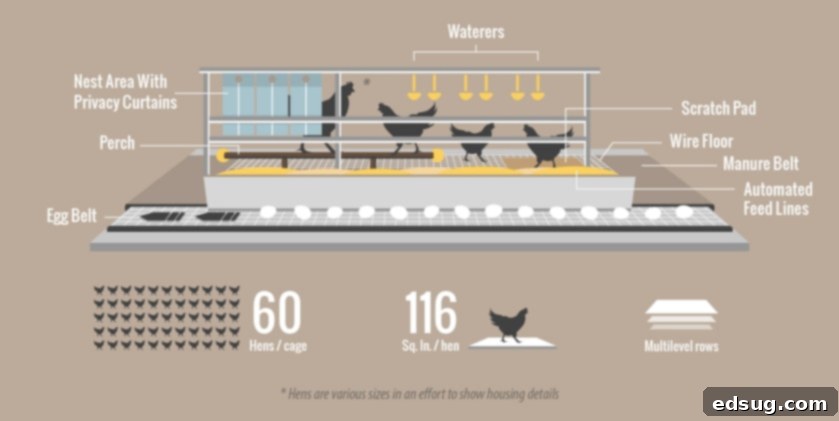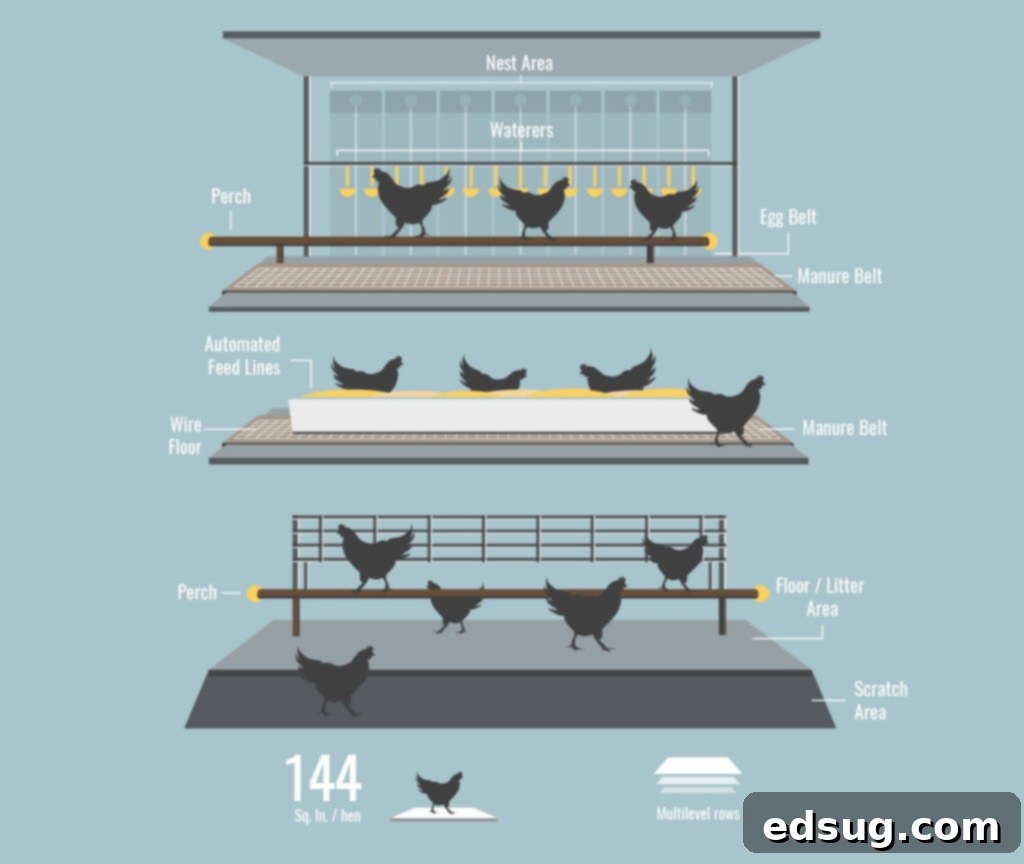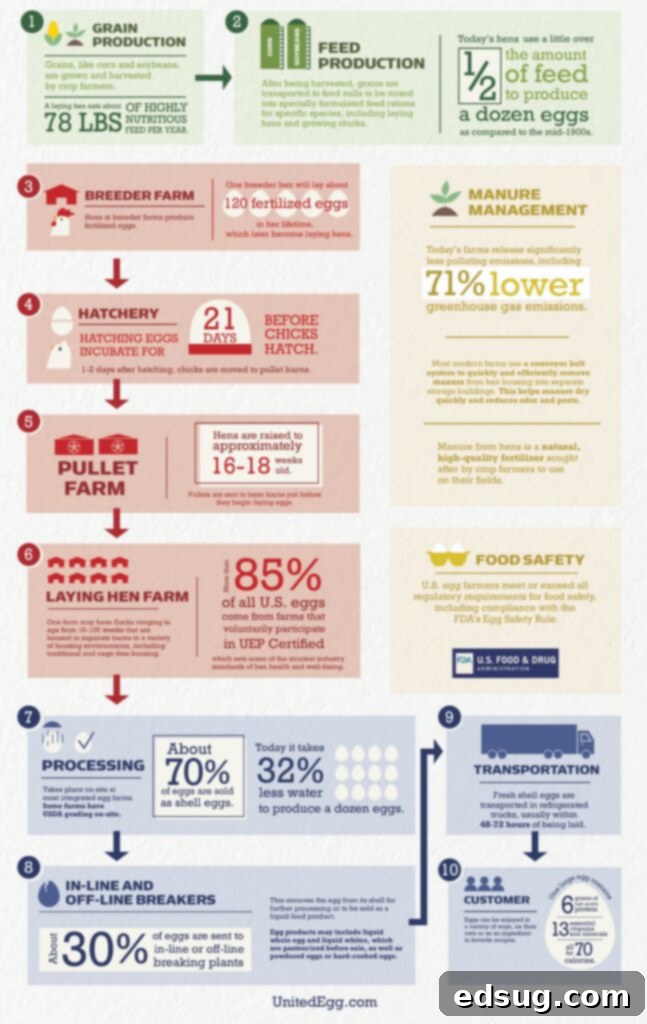Sustainable Egg Farming: Navigating Ethical Practices, Efficiency, and Consumer Choice
This post is sponsored by Best Food Facts. All thoughts and opinions are 100% my own.
I am absolutely thrilled to share what I’ve learned about sustainable egg farming, a topic I recently delved into with great interest. So much of this information was new and enlightening to me. Originally, I had planned a trip to Iowa this summer with Best Food Facts to visit egg producers firsthand and observe their operations. However, as we all know, this summer has presented unforeseen challenges, preventing those in-person visits. Instead, we adapted by conducting a highly informative virtual gathering with some of the industry’s leading experts and dedicated farmers. This digital format allowed us to gain invaluable insights into the intricacies of modern egg production, from animal welfare to environmental stewardship, all from the comfort of our homes.

Understanding Sustainability in Modern Agriculture
The concept of sustainability has become a cornerstone of discussions across the entire food industry, especially in sectors like egg farming. But what does it truly signify in the context of agricultural practices and consumer goods? Dr. Dan Thompson, a distinguished veterinarian and Chair of the Department of Animal Science at Iowa State University, offered a profound perspective during our virtual session. To him, sustainability fundamentally means “leaving things a little bit better than you found it.” This philosophy extends beyond just environmental impact, encompassing responsible farming practices, exemplary animal care, and even the efficiency of the retail side of food distribution. We also had the privilege of speaking with Coby Newbold, who manages retail operations for a major grocery chain in Iowa. He articulated sustainability from a broader market perspective as “meeting the present and future food needs with minimal impact on the environment.”
Across the board, when discussions turn to sustainability in agriculture, there’s a remarkable consensus among farmers, retailers, and experts alike. They are united in their desire to care for animals in the most humane and efficient manner possible, produce enough nutritious food to meet national demand, and deliver it to consumers through the most streamlined and environmentally conscious methods. This holistic approach genuinely benefits everyone involved, from the farmers cultivating the land and raising the hens, to the grocery chains ensuring availability, and ultimately to the consumers who rely on affordable, high-quality food. It’s a complex ecosystem where every decision impacts the delicate balance of production efficiency, animal welfare, and environmental responsibility, all working towards a more resilient food system.
The Unwavering Commitment of Farmers to Animal Welfare

Having had the opportunity to go on several farm tours over the past few years, one consistent truth has always shone through: the deep-seated passion and dedication farmers have for their work. Whether it involves meticulously tending to their crops or diligently raising their animals, their commitment to their livelihood and the welfare of their charges is undeniable. The well-being of their animals consistently stands as the number one priority on any farm. This isn’t merely a moral stance; it’s a fundamental aspect of their operational success and financial stability. If the animals are not healthy, comfortable, and content, they simply won’t produce efficiently. And without adequate production, farmers face significant financial hardship, risking their ability to support their families and continue their vital role in our food system. Healthy animals are productive animals, and a farmer’s success is directly tied to the welfare of their flock.
This dedication is a 24-hour-a-day, seven-day-a-week commitment, irrespective of the weather or time of year. Farmers are constantly vigilant, ensuring their animals are well-cared for. While modern technology increasingly offers assistance, with advanced monitoring systems allowing farmers to keep track of conditions remotely—from temperature and humidity to feed and water levels—there are countless instances where hands-on intervention is indispensable. This might mean trudging through a blizzard in the dead of winter to reach a barn and personally check on the livestock, ensuring they are warm and safe, or working through the scorching heat of summer to ensure proper hydration and ventilation. This unwavering commitment underscores the profound responsibility farmers feel towards every animal under their care, reinforcing their role as true stewards of both the land and its inhabitants, tirelessly working to ensure the best conditions for their animals.
Exploring Diverse Hen Housing Systems for Egg Production

The way hens are housed for egg-laying is a subject of much discussion and innovation, with various systems implemented across the industry. Each method presents its own unique set of advantages and challenges, leading farmers to adopt different approaches to cater to diverse consumer preferences and market demands. The goal is always to provide choice and options on the retail shelf, ensuring that every consumer can find eggs that align with their ethical considerations, budgetary constraints, and personal values. Understanding these systems is key to appreciating the complexity of egg production.
Conventional Cages
Historically, conventional cages, sometimes referred to as battery cages, have been a prevalent method due to their high efficiency and biosecurity benefits. These systems typically have a relatively small footprint, housing around 6-7 chickens per cage. While the chickens have limited space for extensive movement compared to other systems, they are provided with consistent and easy access to fresh feed and water, and their environment is carefully controlled. This method offers several key benefits: it minimizes aggression and cannibalism among hens by preventing the establishment of pecking orders, significantly reduces exposure to parasites and disease from feces (as waste falls through wire floors), and allows for highly efficient monitoring of individual bird health and streamlined egg collection. The controlled environment also contributes significantly to biosecurity and reduces external threats. Consequently, eggs produced in conventional cages are typically the most cost-effective option available at the grocery store, making them accessible to a broad range of consumers for whom affordability is a primary concern.
Enriched Colony Cages
Representing a significant evolution in hen housing, enriched colony cages offer a substantially larger footprint and more expansive living space for chickens to move around compared to conventional cages. These systems typically accommodate approximately 60 chickens in a single, larger enclosure, providing communal space while retaining many of the management benefits of controlled environments. Crucially, they are designed to facilitate key natural behaviors for hens, equipped with essential features such as private nesting boxes for laying eggs, elevated perches for roosting (which hens naturally seek out), and scratching areas for dust bathing and foraging behaviors. These three elements — nesting, perching, and scratching — are recognized as highly important for the physical and psychological well-being of a healthy hen, allowing them to express more of their natural instincts. A growing body of scientific research and ongoing studies increasingly demonstrate that enriched colony cages strike an optimal balance, providing significant welfare improvements for the birds, enhancing working conditions for farm personnel due to better organization, maintaining high standards of food safety through cleaner environments, and promoting overall sustainability in egg production. Eggs from these systems typically fall into a mid-range price point at the store, offering an accessible premium option that balances welfare and affordability.
Cage-Free Systems
In cage-free systems, hens are able to roam freely within a designated building, often having access to multiple levels, communal areas, and varied environments with litter. This freedom allows them to engage in a wide range of natural behaviors, including unrestricted movement, foraging, and complex social interaction. However, this increased freedom also introduces unique challenges for farmers and the hens themselves. It becomes significantly harder to monitor individual bird health, prevent aggression within the flock (as hens establish pecking orders and disputes can escalate), and ensure that every hen receives adequate nutrition and care, as feed and water access can be competitive. Furthermore, managing food safety can become a more prominent concern, as chickens roaming freely are more likely to come into contact with their own feces and other environmental elements that could harbor harmful bacteria, necessitating more intensive cleaning and management protocols to mitigate disease transmission. Consequently, caring for cage-free hens requires an estimated two to three times the amount of labor compared to conventional or enriched colony systems due to the need for more frequent litter management, bird monitoring, and facility maintenance. This increased labor, coupled with greater feed consumption due to more movement, and potential for higher mortality rates from disease or aggression, directly contributes to the significantly higher cost of cage-free eggs at the grocery store.

Health and Happiness: A Scientific Perspective on Hen Welfare
Ongoing research and extensive studies continue to shed light on the most effective housing systems for promoting the health and happiness of laying hens. Intriguingly, many studies are indicating that enriched colony cages are emerging as a leading system in terms of overall bird welfare. In these environments, farmers can adopt a more hands-off approach, allowing the chickens to exhibit more natural behaviors without the common pitfalls of completely open systems. It’s important to recognize that not all “natural” behaviors are inherently beneficial for the birds. Much like humans, certain natural inclinations can lead to negative outcomes. For instance, in completely open, cage-free environments, hens can exhibit problematic behaviors such as excessive feather pecking, cannibalism (often a result of stress or pecking order disputes), or huddling, which can lead to injury, stress, suffocation, and higher mortality rates within the flock. In well-managed enriched colony cages, farmers are better positioned to observe these behaviors and intervene effectively, adjusting conditions or management practices to ensure the hens remain healthy, safe, and productive, optimizing their environment for their specific needs rather than allowing unfettered “natural” interactions which can sometimes be detrimental.
A truly fascinating and often overlooked fact is that regardless of the housing system a hen is raised in—be it conventional, enriched colony, or cage-free—the nutritional value of the eggs remains remarkably consistent. The core nutritional profile, including protein, essential vitamins (like B12 and D), and vital minerals (such as selenium and choline), is primarily determined by the hen’s diet and genetic factors, not by the amount of space she has to roam or whether she is in a cage. American farmers are highly responsive to consumer demand, and the diversity in housing systems directly reflects the desire to provide a wide array of choices on supermarket shelves. This ensures that every consumer can select the type of egg that best suits their ethical considerations, dietary preferences, and financial budget. Eggs represent an incredibly affordable, versatile, and nutrient-dense food source that plays a crucial role in sustaining individuals and families across all income levels. Therefore, ensuring the availability of different types of eggs is paramount to maintaining food security and providing essential, accessible nutrition for our diverse society, catering to varied needs and preferences.
The Circular Economy in Egg Farming: A Model of Sustainability

Every farmer I’ve had the privilege of speaking with shares a common, unwavering focus on sustainability. For them, it’s not just a buzzword or a trend; it’s an operational imperative that underpins their ability to continue farming for generations, ensuring the longevity of their land and their livelihood. Cameron Hall, the farm manager at the Iowa State University poultry research farm, provided an excellent illustration of this principle through their specific, mutually beneficial partnership with a neighboring corn farm. This symbiotic relationship exemplifies a practical and highly effective application of the circular economy within agriculture, minimizing waste and maximizing resource utility.
This partnership works seamlessly: the corn farmer provides locally grown corn to feed the poultry at the university farm, ensuring a fresh, reliable, and often more sustainable feed source by reducing transportation distances. In a reciprocal arrangement, the university farm then supplies the corn farmer with nutrient-rich chicken manure for their fields. Chicken manure is, in fact, recognized as one of the most well-rounded and effective natural fertilizers available. It is exceptionally rich in essential plant nutrients like nitrogen, phosphorus, and potassium, as well as vital micronutrients necessary for robust plant growth. When applied to fields, it significantly enhances soil health, improves soil structure, boosts crop yields, and promotes a healthy microbial ecosystem in a natural and environmentally friendly way. This closes the loop in the agricultural system: what is considered a byproduct from one operation becomes an invaluable input for another. This practice substantially reduces the need for synthetic chemical fertilizers, lowers transportation costs, minimizes waste generation, and contributes significantly to the overall environmental sustainability and economic viability of both farms. It’s a testament to how innovative partnerships and resourceful management are driving the future of sustainable food production, benefiting both the environment and the local economy.
Adapting to Evolving Demands and Building Consumer Trust
Farming is an inherently dynamic and ever-changing landscape, constantly influenced by shifts in consumer preferences, technological advancements, scientific research, and environmental conditions. Modern farmers are not only caretakers of land and animals but also agile entrepreneurs and innovators who continuously adapt their practices to meet these new demands. When consumer expectations evolve, whether concerning animal welfare standards, environmental impact (such as carbon footprint), or the variety and type of products available, farmers meticulously adjust their practices, invest in new technologies, and modify their infrastructure. This remarkable adaptability is critical for the industry’s resilience and its ongoing capacity to consistently provide safe, nutritious, and affordable food for a growing global population.
An integral component of maintaining an affordable and accessible food supply, especially in a world with increasing complexities, is fostering a deeper understanding of where our food originates and, crucially, building unwavering trust in the farmers who produce it. Transparency about farming practices, coupled with open communication about the challenges and innovations in agriculture, empowers consumers to make informed choices that align with their values. By recognizing the immense effort, expertise, dedication, and often personal sacrifice involved in bringing food to our tables, we can better appreciate the complex journey of our meals and actively support the sustainable practices that ensure a bountiful and secure future for everyone. Investing in education, promoting dialogue, and fostering direct connections between consumers and producers are vital steps toward building a more transparent, sustainable, and trustworthy food system for generations to come.
